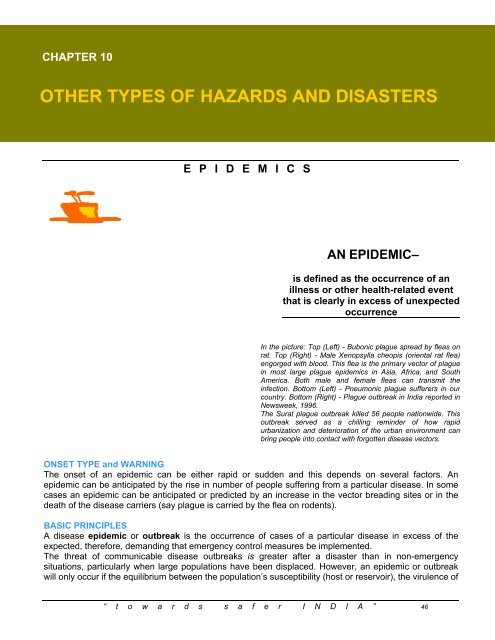Hazards, Disasters And Your Community - United Nations ...
Hazards, Disasters And Your Community - United Nations ...
Hazards, Disasters And Your Community - United Nations ...
You also want an ePaper? Increase the reach of your titles
YUMPU automatically turns print PDFs into web optimized ePapers that Google loves.
www.uneptie.org/pc/apell the (UNEP) has developed a programme called as APELL, in conjunction with governments and<br />
CHAPTER industry with the 10 purpose of minimizing the occurrence and harmful effects of technological accidents and environmental<br />
emergencies.<br />
OTHER TYPES OF HAZARDS AND DISASTERS<br />
E P I D E M I C S<br />
AN EPIDEMIC–<br />
is defined as the occurrence of an<br />
illness or other health-related event<br />
that is clearly in excess of unexpected<br />
occurrence<br />
In the picture: Top (Left) - Bubonic plague spread by fleas on<br />
rat. Top (Right) - Male Xenopsylla cheopis (oriental rat flea)<br />
engorged with blood. This flea is the primary vector of plague<br />
in most large plague epidemics in Asia, Africa, and South<br />
America. Both male and female fleas can transmit the<br />
infection. Bottom (Left) - Pneumonic plague sufferers in our<br />
country. Bottom (Right) - Plague outbreak in India reported in<br />
Newsweek, 1996.<br />
The Surat plague outbreak killed 56 people nationwide. This<br />
outbreak served as a chilling reminder of how rapid<br />
urbanization and deterioration of the urban environment can<br />
bring people into contact with forgotten disease vectors.<br />
ONSET TYPE and WARNING<br />
The onset of an epidemic can be either rapid or sudden and this depends on several factors. An<br />
epidemic can be anticipated by the rise in number of people suffering from a particular disease. In some<br />
cases an epidemic can be anticipated or predicted by an increase in the vector breading sites or in the<br />
death of the disease carriers (say plague is carried by the flea on rodents).<br />
BASIC PRINCIPLES<br />
A disease epidemic or outbreak is the occurrence of cases of a particular disease in excess of the<br />
expected, therefore, demanding that emergency control measures be implemented.<br />
The threat of communicable disease outbreaks is greater after a disaster than in non-emergency<br />
situations, particularly when large populations have been displaced. However, an epidemic or outbreak<br />
will only occur if the equilibrium between the population’s susceptibility (host or reservoir), the virulence of<br />
“ t o w a r d s s a f e r I N D I A ” 46

















